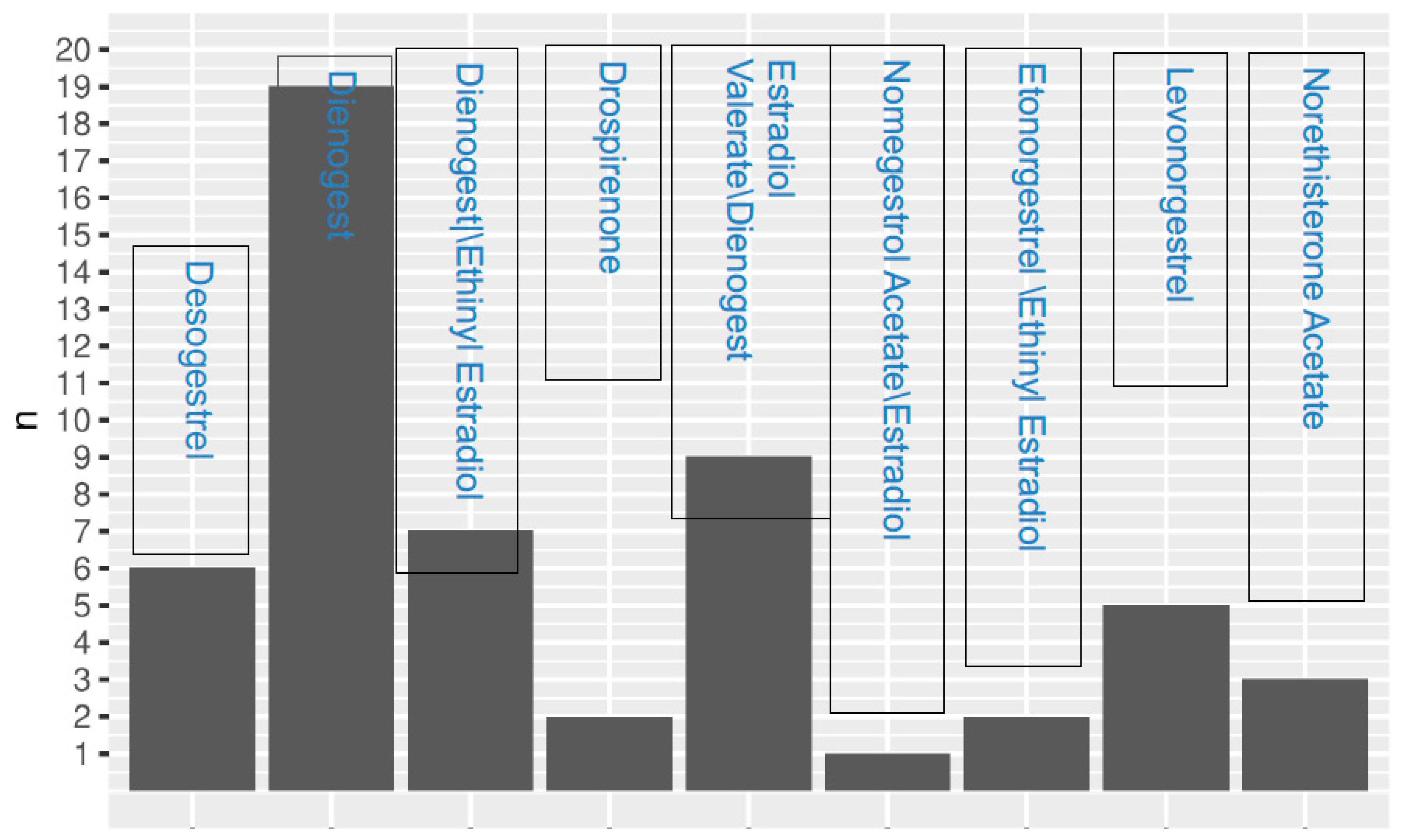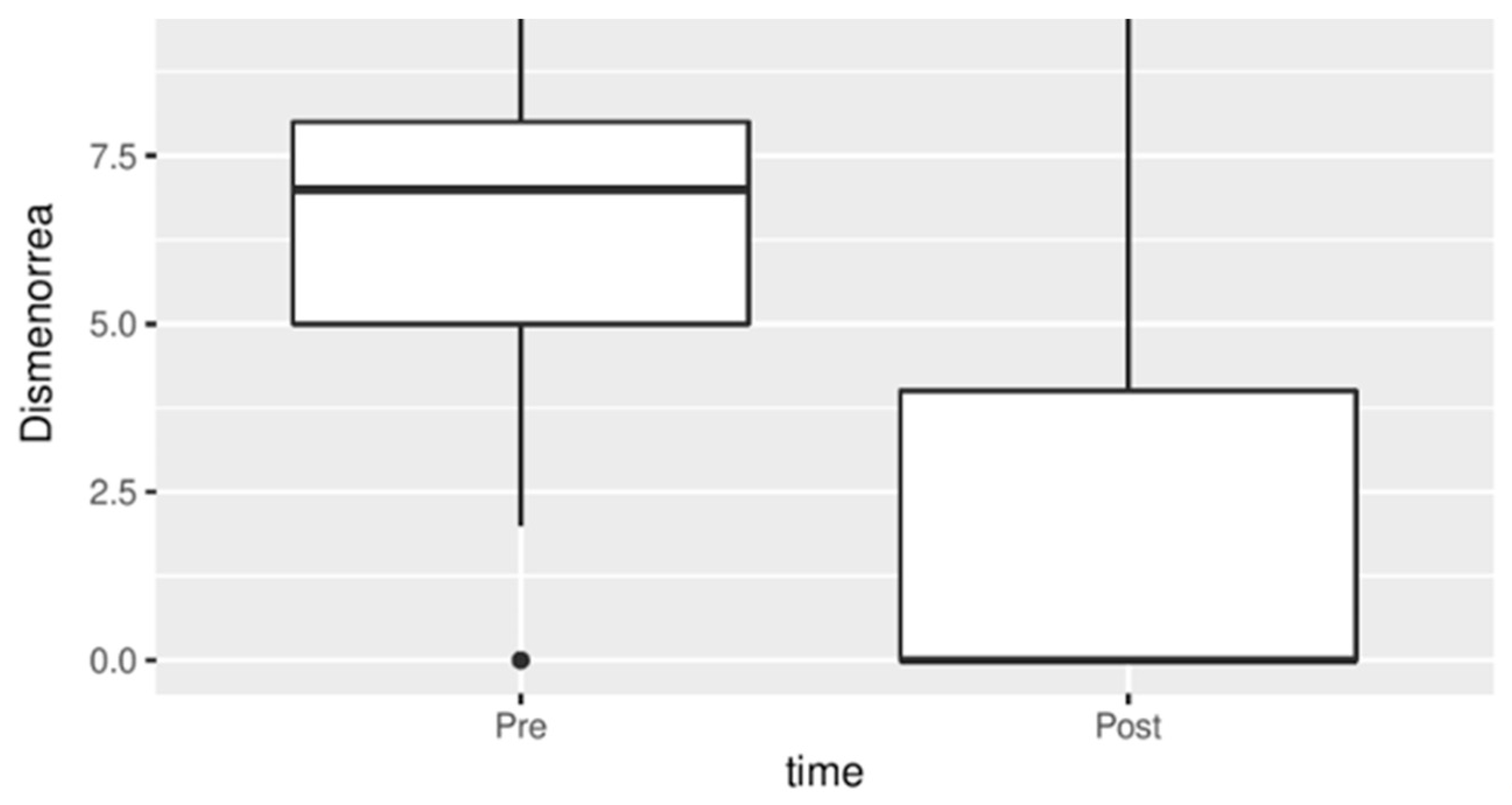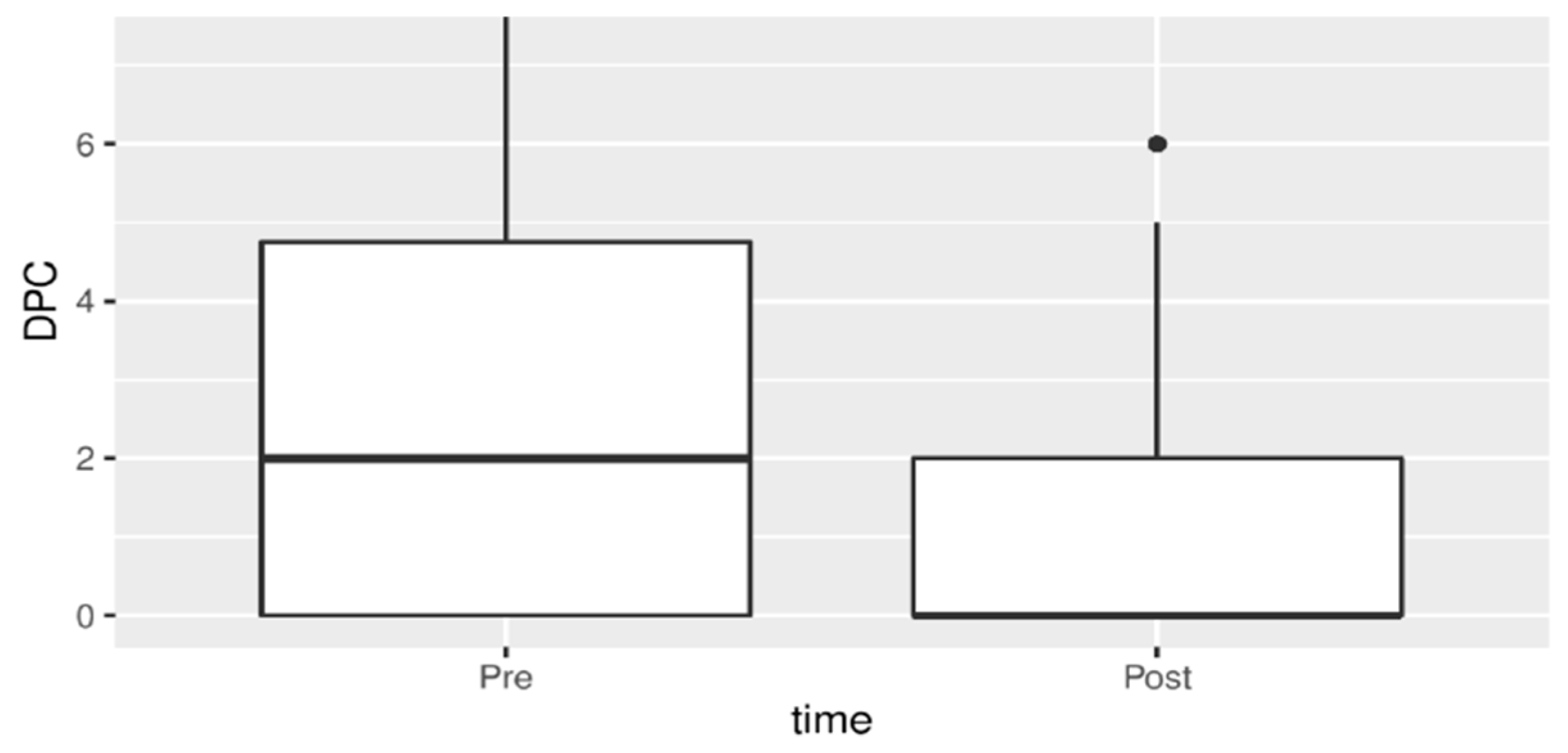Does Sexual Function and Quality of Life Improve after Medical Therapy in Women with Endometriosis? A Single-Institution Retrospective Analysis
Abstract
:1. Introduction
2. Materials and Methods
2.1. Study Design
2.2. Diagnosis of Endometriosis
2.3. Patient Characteristics
- -
- SF-36 (Short Form-36 Health Survey) assessing quality of life and health satisfaction. It is composed of 36 multiple choice questions aggregated into 8 scales that investigate Physical Activity, Role and Physical Health, Physical Pain, Health in General, Vitality, Social Aactivities, Mental Health, Role and Emotional State; there is also a question about the change in health status during the last year [23,24]. The higher the score, the better the subject’s health.
- -
- STAI (State-Trait Anxiety Inventory), a psychological questionnaire based on a 4-point Likert scale. Low scores indicate a mild form of anxiety, while intermediate scores indicate a moderate form of anxiety and high scores indicate a severe form of anxiety [25].
- -
- FSFI (Female Sexual Function Index), a validated tool for assessing the main aspects of female sexual dysfunction and sexual satisfaction. The FSFI contains six domains: desire, arousal, lubrication, orgasm, satisfaction, and pain. These domains assess sexual function over the past 4 weeks [26].
2.4. Ethics Committee
2.5. Study Power
2.6. Statistical Analysis
3. Results
4. Discussion
5. Conclusions
Author Contributions
Funding
Institutional Review Board Statement
Informed Consent Statement
Data Availability Statement
Conflicts of Interest
References
- Holland, T.K.; Cutner, A.; Saridogan, E.; Mavrelos, D.; Pateman, K.; Jurkovic, D. Ultrasound mapping of pelvic endometriosis: Does the location and number of lesions affect the diagnostic accuracy? A multicentre diagnostic accuracy study. BMC Womens Health 2013, 13, 43. [Google Scholar] [CrossRef] [PubMed]
- Zondervan, K.T.; Becker, C.M.; Missmer, S.A. Endometriosis. N. Engl. J. Med. 2020, 382, 1244–1256. [Google Scholar] [CrossRef] [PubMed]
- Symons, L.K.; Miller, J.E.; Kay, V.R. The immunopathophysiology of endometriosis. Trends Mol. Med. 2018, 24, 748–762. [Google Scholar] [CrossRef] [PubMed]
- Gruber, T.M.; Mechsner, S. Pathogenesis of Endometriosis: The Origin of Pain and Subfertility. Cells 2021, 10, 1381. [Google Scholar] [CrossRef] [PubMed]
- Nnoaham, K.E.; Hummelshoj, L.; Kennedy, S.H.; Jenkinson, C.; Zondervan, K.T. Developing symptom-based predictive models of endometriosis as a clinical screening tool: Results from a multicenter study. Fertil. Steril. 2012, 98, 692–701.e5. [Google Scholar] [CrossRef] [PubMed]
- Ballard, K.D.; Seaman, H.E.; de Vries, C.S.; Wright, J.T. Can symptomatology help in the diagnosis of endometriosis? Findings from a national case-control study—Part 1. BJOG Int. J. Obstet. Gynaecol. 2008, 115, 1382–1391. [Google Scholar] [CrossRef]
- Soliman, A.M.; Fuldeore, M.; Snabes, M.C. Factors Associated with Time to Endometriosis Diagnosis in the United States. J. Womens Health 2017, 26, 788–797. [Google Scholar] [CrossRef]
- La Rosa, V.L.; De Franciscis, P.; Barra, F.; Schiattarella, A.; Török, P.; Shah, M.; Karaman, E.; Marques Cerentini, T.; Di Guardo, F.; Gullo, G.; et al. Quality of life in women with endometriosis: A narrative overview. Minerva Med. 2020, 111, 68–78. [Google Scholar] [CrossRef]
- Haraldstad, K.; Wahl AAndenæs, R.; Andersen JR Andersen, M. HA systematic review of quality of life research in medicine and health sciences. Qual. Life Res. 2019, 28, 2641–2650. [Google Scholar] [CrossRef]
- Mayo, N. Dictionary of Quality of Life and Health Outcomes Measurement; International Society for Quality of Life Research (ISOQOL): Milwaukee, WI, USA, 2015; Available online: https://books.google.it/books?id=cKjksgEACAAJ (accessed on 5 November 2023).
- Souza, C.A.; Oliveira, L.M.; Scheffel, C.; Genro, V.K.; Rosa, V.; Chaves, M.F.; Cunha Filho, J.S. Quality of life associated to chronic pelvic pain is independent of endometriosis diagnosis—A cross-sectional survey. Health Qual. Life Outcomes 2011, 9, 41. [Google Scholar] [CrossRef]
- Ferrero, S.; Esposito, F.; Abbamonte, L.H.; Anserini, P.; Remorgida, V.; Ragni, N. Quality of sex life in women with endometriosis and deep dyspareunia. Fertil. Steril. 2005, 83, 573–579. [Google Scholar] [CrossRef] [PubMed]
- Johnson, N.P.; Hummelshoj, L. Consensus on current management of endometriosis. Hum. Reprod. 2013, 28, 1552–1568. [Google Scholar] [CrossRef] [PubMed]
- Johnson, N.P.; Hummelshoj, L.; Adamson, G.; Allaire, C.; Amelung, V.; Andersson, E.; Becker, C.; Birna Árdal, K. World Endometriosis Society consensus on the classification of endometriosis. Hum. Reprod. 2017, 32, 315–324. [Google Scholar] [CrossRef] [PubMed]
- Andres Mde, P.; Lopes, L.A.; Baracat, E.C.; Podgaec, S. Dienogest in the treatment of endometriosis: Systematic review. Arch. Gynecol. Obstet. 2015, 292, 523–529. [Google Scholar] [CrossRef] [PubMed]
- Grandi, G.; Barra, F.; Ferrero, S.; Sileo, F.G.; Bertucci, E.; Napolitano, A.; Facchinetti, F. Hormonal contraception in women with endometriosis: A systematic review. Eur. J. Contracept. Reprod. Health Care 2019, 24, 61–70. [Google Scholar] [CrossRef]
- Caruso, S.; Agnello, C.; Romano, M.; Cianci, S.; Lo Presti, L.; Malandrino, C.; Cianci, A. Preliminary study on the effect of fourphasic estradiol valerate and dienogest (E2V/DNG) oral contraceptive on the quality of sexual life. J. Sex. Med. 2011, 8, 2841–2850. [Google Scholar] [CrossRef] [PubMed]
- Alcalde, A.M.; Martínez-Zamora, M.Á.; Gracia, M.; Ros, C.; Rius, M.; Castelo-Branco, C.; Carmona, F. Assessment of Quality of Life, Sexual Quality of Life, and Pain Symptoms in Deep Infiltrating Endometriosis Patients with or Without Associated Adenomyosis and the Influence of a Flexible Extended Combined Oral Contraceptive Regimen: Results of a Prospective, Observational Study. J. Sex. Med. 2022, 19, 311–318. [Google Scholar] [CrossRef]
- Guerriero, S.; Condous, G.; van den Bosch, T.; Valentin, L.; Leone, F.P.; Van Schoubroeck, D.; Exacoustos, C.; Installé, A.J.; Martins, W.P.; Abrao, M.S.; et al. Systematic approach to sonographic evaluation of the pelvis in women with suspected endometriosis, including terms, definitions and measurements: A consensus opinion from the International Deep Endometriosis Analysis (IDEA) group. Ultrasound Obs. Gynecol. 2016, 48, 318–332. [Google Scholar] [CrossRef]
- Bazot, M.; Daraï, E. Diagnosis of deep endometriosis: Clinical examination, ultrasonography, magnetic resonance imaging, and other techniques. Fertil. Steril. 2017, 108, 886–894. [Google Scholar] [CrossRef]
- Nisenblat, V.; Bossuyt, P.M.M.; Farquhar, C.; Johnson, N.; Hull, M.L. Imaging modalities for the non-invasive diagnosis of endometriosis. Cochrane Database Syst. Rev. 2016, 2016, CD009591. [Google Scholar] [CrossRef]
- Becker, C.M.; Bokor, A.; Heikinheimo, O.; Horne, A.; Jansen, F.; Kiesel, L.; King, K.; Kvaskoff, M.; Nap, A.; Petersen, K.; et al. ESHRE guideline: Endometriosis. Hum. Reprod. Open 2022, 2022, hoac009. [Google Scholar] [CrossRef] [PubMed]
- Eriksen, H.L.F.; Gunnersen, K.F.; Sørensen, J.A.; Munk, T.; Nielsen, T.; Knudsen, U.B. Psychological aspects of endometriosis: Differences between patients with or without pain on four psychological variables. Eur. J. Obstet. Gynecol. Reprod. Biol. 2008, 139, 100–105. [Google Scholar] [CrossRef] [PubMed]
- Busija, L.; Pausenberger, E.; Haines, T.P.; Haymes, S.; Buchbinder, R.; Osborne, R.H. Adult measures of general health and health-related quality of life: Medical Outcomes Study Short Form 36-Item (SF-36) and Short Form 12-Item (SF-12) Health Surveys, Nottingham Health Profile (NHP), Sickness Impact Profile (SIP), Medical Outcomes Study Short Form 6D (SF-6D), Health Utilities Index Mark 3 (HUI3), Quality of Well-Being Scale (QWB), and Assessment of Quality of Life (AQoL). Arthritis Care Res. 2011, 63, S383–S412. [Google Scholar] [CrossRef]
- Knowles, K.A.; Olatunji, B.O. Specificity of trait anxiety in anxiety and depression: Meta-analysis of the State-Trait Anxiety Inventory. Clin. Psychol. Rev. 2020, 82, 101928. [Google Scholar] [CrossRef]
- Shaeer, O.; Skakke, D.; Giraldi, A.; Shaeer, E.; Shaeer, K. Female Orgasm and Overall Sexual Function and Habits: A Descriptive Study of a Cohort of U.S. Women. J. Sex. Med. 2020, 17, 1133–1143. [Google Scholar] [CrossRef]
- Simon, R. Optimal two stage design for phase II clinical trials. Control Clin. Trials 1989, 10, 1–10. [Google Scholar] [CrossRef]
- National Institute for Health and Care Excellence. Endometriosis: Diagnosis and Management. NICE Guideline NG73. 2017. Available online: https://www.nice.org.uk/guidance/ng73/evidence/full-guideline-pdf-4550371315 (accessed on 5 November 2023).
- Caruso, S.; Iraci, M.; Cianci, S.; Casella, E.; Fava, V.; Cianci, A. Quality of life and sexual function of women affected by endometriosis-associated pelvic pain when treated with dienogest. J. Endocrinol. Invest. 2015, 38, 1211–1218. [Google Scholar] [CrossRef]
- Grandi, G.; Xholli, A.; Napolitano, A.; Palma, F.; Cagnacci, A. Pelvic pain and quality of life of women with endometriosis during quadriphasic estradiol valerate/dienogest oral contraceptive. A patient-preference prospective 24-week pilot study. Reprod. Sci. 2015, 22, 626–632. [Google Scholar] [CrossRef]
- Caruso, S.; Iraci, M.; Cianci, S.; Vitale, S.G.; Fava, V.; Cianci, A. Effects of long-term treatment with Dienogest on the quality of life and sexual function of women affected by endometriosis-associated pelvic pain. J. Pain. Res. 2019, 29, 2371–2378. [Google Scholar] [CrossRef]
- Sima, R.M.; Pleş, L.; Socea, B.; Sklavounos, P.; Negoi, I.; Stănescu, A.D.; Iordache, I.I.; Hamoud, B.H.; Radosa, M.P.; Juhasz-Boess, I.; et al. Evaluation of the SF-36 questionnaire for assessment of the quality of life of endometriosis patients undergoing treatment: A systematic review and meta-analysis. Exp. Ther. Med. 2021, 22, 1283. [Google Scholar] [CrossRef]
- Mabrouk, M.; Montanari, G.; Guerrini, M.; Villa, G.; Solfrini, S.; Vicenzi, C.; Mignemi, G.; Zannoni, L.; Frasca, C.; Di Donato, N.; et al. Does laparoscopic management of deep infiltrating endometriosis improve quality of life? A prospective study. Health Qual. Life Outcomes. 2011, 9, 98. [Google Scholar] [CrossRef] [PubMed]
- Mabrouk, M.; Frascà, C.; Geraci, E.; Montanari, G.; Ferrini, G.; Raimondo, D.; Alvisi, S.; Paradisi, R.; Villa, G.; Seracchioli, R. Combined oral contraceptive therapy in women with posterior deep infiltrating endometriosis. J. Minim. Invasive Gynecol. 2011, 18, 470–474. [Google Scholar] [CrossRef] [PubMed]
- Van Stein, K.; Schubert, K.; Ditzen, B.; Weise, C. Understanding Psychological Symptoms of Endometriosis from a Research Domain Criteria Perspective. J. Clin. Med. 2023, 12, 4056. [Google Scholar] [CrossRef] [PubMed]
- Kalfas, M.; Chisari, C.; Windgassen, S. Psychosocial factors associated with pain and health-related quality of life in Endometriosis: A systematic review. Eur. J. Pain. 2022, 26, 1827–1848. [Google Scholar] [CrossRef]
- Pluchino, N.; Wenger, J.M.; Petignat, P.; Tal, R.; Bolmont, M.; Taylor, H.S.; Bianchi-Demicheli, F. Sexual function in endometriosis patients and their partners: Effect of the disease and consequences of treatment. Hum. Reprod. Update 2016, 22, 762–774. [Google Scholar] [CrossRef] [PubMed]
- Chiarotto, A.; Viti, C.; Sulli, A.; Cutolo, M.; Testa, M.; Piscitelli, D. Cross-cultural adaptation and validity of the Italian version of the Central Sensitization Inventory. Musculoskelet. Sci. Pract. 2018, 37, 20–28. [Google Scholar] [CrossRef] [PubMed]
- McNamara, H.C.; Frawley, H.C.; Donoghue, J.F.; Readman, E.; Healey, M.; Ellett, L.; Reddington, C.; Hicks, L.J.; Harlow, K.; Rogers, P.A.W.; et al. Peripheral, Central, and Cross Sensitization in Endometriosis-Associated Pain and Comorbid Pain Syndromes. Front. Reprod. Health 2021, 3, 729642. [Google Scholar] [CrossRef]
- Fitzcharles, M.A.; Cohen, S.P.; Clauw, D.J.; Littlejohn, G.; Usui, C.; Häuser, W. Nociplastic pain: Towards an understanding of prevalent pain conditions. Lancet 2021, 397, 2098–2110. [Google Scholar] [CrossRef]
- Kosek, E.; Cohen, M.; Baron, R.; Gebhart, G.F.; Mico, J.A.; Rice, A.S.C.; Rief, W.; Sluka, A.K. Do we need a third mechanistic descriptor for chronic pain states? Pain 2016, 157, 1382–1386. [Google Scholar] [CrossRef]
- Nijs, J.; Lahousse, A.; Kapreli, E.; Bilika, P.; Saraçoğlu, I.; Malfliet, A.; Coppieters, I.; De Baets, L.; Leysen, L.; Roose, E.; et al. Nociplastic Pain Criteria of Recognition of Central Sensitization? Pain Phenotyping in the Past, Present and Future. J. Clin. Med. 2021, 10, 3203. [Google Scholar] [CrossRef]
- Raimondo, D.; Raffone, A.; Renzulli, F.; Sanna, G.; Raspollini, A.; Bertoldo, L.; Maletta, M.; Lenzi, J.; Rovero, G.; Travaglino, A.; et al. Prevalence and Risk Factors of Central Sensitization in Women with Endometriosis. J. Minim. Invasive Gynecol. 2023, 30, 73–80.e1. [Google Scholar] [CrossRef] [PubMed]
- Ji, R.R.; Nackley, A.; Huh, Y.; Terrando, N.; Maixner, W. Neuroinflammation and Central Sensitization in Chronic and Widespread Pain. Anesthesiology 2018, 129, 343–366. [Google Scholar] [CrossRef] [PubMed]
- Orr, N.L.; Wahl, K.J.; Lisonek, M.; Joannou, A.; Noga, H.; Albert, A.; Bedaiwy, M.A.; Williams, C.; Allaire, C.; Yong, P.J. Central sensitization inventory in endometriosis. Pain 2022, 163, e234–e245. [Google Scholar] [CrossRef] [PubMed]
- Penariol, L.B.C.; Thomé, C.H.; Tozetti, P.A.; Paier, C.R.K.; Buono, F.O.; Peronni, K.C.; Orellana, M.D.; Covas, D.T.; Moraes, M.E.A.; Silva, W.A., Jr.; et al. What Do the Transcriptome and Proteome of Menstrual Blood-Derived Mesenchymal Stem Cells Tell Us about Endometriosis? Int. J. Mol. Sci. 2022, 23, 11515. [Google Scholar] [CrossRef]
- Ugwumadu, L.; Chakrabarti, R.; Williams-Brown, E.; Rendle, J.; Swift, I.; John, B.; Allen-Coward, H.; Ofuasia, E. The role of the multidisciplinary team in the management of deep infiltrating endometriosis. Gynecol. Surg. 2017, 14, 15. [Google Scholar] [CrossRef]





| Age | 34.54 (±8.75) |
| BMI (Body Mass Index) | 22 (20–25) |
| Comorbidity * | 33.33% (18/54) |
| Smoking | 25.93% (14/54) |
| Adenomyosis | 50% (27/54) |
| Superficial endometriosis | 16.67% (9/54) |
| Ovarian endometriosis | 59.26% (32/54) |
| Deep endometriosis | 46.3% (25/54) |
| Before therapy | |
| Dysmenorrhea.NRS ** | 7 (5–8) |
| Chronic pelvic pain.NRS ** | 2 (0–5) |
| Dischezia.NRS ** | 0 (0–0) |
| Dysuria.NRS ** | 0 (0–0) |
| Dyspareunia.NRS ** | 0 (0–5) |
| Post therapy | |
| Dysmenorrhea.NRS.1 ** | 0 (0–4) |
| Hronic pelvic pain.NRS.1 ** | 0 (0–2) |
| Discgezia.NRS.1 ** | 0 (0–0) |
| Dysuria.NRS.1 ** | 0 (0–0) |
| Dyspareunia.NRS.1 ** | 0 (0–3) |
| Before therapy | |
| P.STAI | 45 (37–55) |
| P.FSFI | 24 (18–28) |
| P.SF36 | 96 (85–105) |
| Post therapy | |
| D.STAI | 42 (37–54) |
| D.FSFI | 20 (6–27) |
| D.SF36 | 96 (88–108) |
| Before | After | |||
|---|---|---|---|---|
| NRS | ds | NRS | ds | |
| Dysmenorhea | 7 | (5–8) | 0 | (0–4) |
| Chronic pelvic pain | 2 | (0–5) | 0 | (0–2) |
| ITEM FSI | CLASS | T0 | T4 | p-Value |
|---|---|---|---|---|
| Mean + SD | Mean + SD | |||
| 1 | DESIRE | 3 (2–4) | 3 (1.25–3) | 0.061 |
| 2 | 3 (2–3.75) | 3 (2–3) | 0.079 | |
| 3 | STIMULATION | 3 (1.25–5) | 3 (1–4.75) | 0.1 |
| 4 | 3 (2–4) | 3 (1–4) | 0.0041 | |
| 5 | 3.5 (2–4) | 2.5 (1–4) | 0.011 | |
| 6 | 4 (1.25–4.75) | 3 (0–5) | 0.099 | |
| 7 | LUBRICATION | 4 (2–5) | 3 (0–4) | 0.016 |
| 8 | 2 (1–2) | 1 (0–2) | 0.095 | |
| 9 | 4 (2–5) | 3 (0–5) | 0.062 | |
| 10 | 2 (1–2) | 1.5 (0–2) | 0.13 | |
| 11 | ORGASM | 4 (2–5) | 3 (0–5) | 0.023 |
| 12 | 2 (1–2.75) | 1 (0–2) | 0.084 | |
| 13 | SATISFACTION | 4 (1.25–4.75) | 2 (0–4) | 0.0085 |
| 14 | 4 (1–5) | 3 (0–5) | 0.12 | |
| 15 | 4 (3–4.75) | 3.5 (3–4.75) | 0.54 | |
| 16 | 4 (2.25–4) | 3.5 (3–4) | 0.47 | |
| 17 | DYSPAREUNIA | 2.5 (1–5) | 3 (0–4) | 0.51 |
| 18 | 3 (1–4) | 3 (0–4) | 0.93 | |
| 19 | 3 (2–4) | 3 (0–4) | 0.3 | |
| TOTAL | 24 (18–28) | 20 (6–27) | 0.036 |
Disclaimer/Publisher’s Note: The statements, opinions and data contained in all publications are solely those of the individual author(s) and contributor(s) and not of MDPI and/or the editor(s). MDPI and/or the editor(s) disclaim responsibility for any injury to people or property resulting from any ideas, methods, instructions or products referred to in the content. |
© 2023 by the authors. Licensee MDPI, Basel, Switzerland. This article is an open access article distributed under the terms and conditions of the Creative Commons Attribution (CC BY) license (https://creativecommons.org/licenses/by/4.0/).
Share and Cite
Biasioli, A.; Zermano, S.; Previtera, F.; Arcieri, M.; Della Martina, M.; Raimondo, D.; Raffone, A.; Restaino, S.; Vizzielli, G.; Driul, L. Does Sexual Function and Quality of Life Improve after Medical Therapy in Women with Endometriosis? A Single-Institution Retrospective Analysis. J. Pers. Med. 2023, 13, 1646. https://doi.org/10.3390/jpm13121646
Biasioli A, Zermano S, Previtera F, Arcieri M, Della Martina M, Raimondo D, Raffone A, Restaino S, Vizzielli G, Driul L. Does Sexual Function and Quality of Life Improve after Medical Therapy in Women with Endometriosis? A Single-Institution Retrospective Analysis. Journal of Personalized Medicine. 2023; 13(12):1646. https://doi.org/10.3390/jpm13121646
Chicago/Turabian StyleBiasioli, Anna, Silvia Zermano, Francesca Previtera, Martina Arcieri, Monica Della Martina, Diego Raimondo, Antonio Raffone, Stefano Restaino, Giuseppe Vizzielli, and Lorenza Driul. 2023. "Does Sexual Function and Quality of Life Improve after Medical Therapy in Women with Endometriosis? A Single-Institution Retrospective Analysis" Journal of Personalized Medicine 13, no. 12: 1646. https://doi.org/10.3390/jpm13121646
APA StyleBiasioli, A., Zermano, S., Previtera, F., Arcieri, M., Della Martina, M., Raimondo, D., Raffone, A., Restaino, S., Vizzielli, G., & Driul, L. (2023). Does Sexual Function and Quality of Life Improve after Medical Therapy in Women with Endometriosis? A Single-Institution Retrospective Analysis. Journal of Personalized Medicine, 13(12), 1646. https://doi.org/10.3390/jpm13121646








